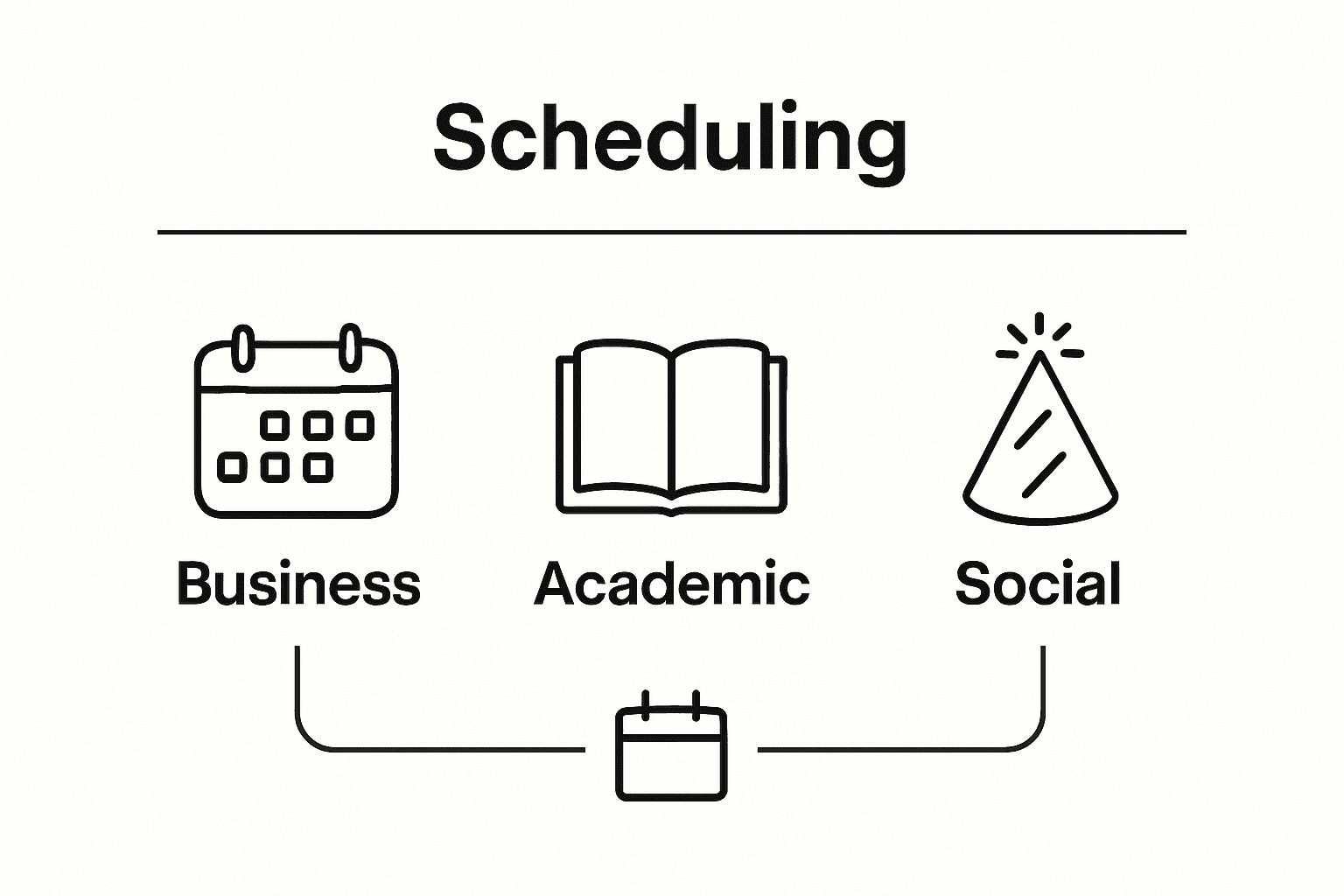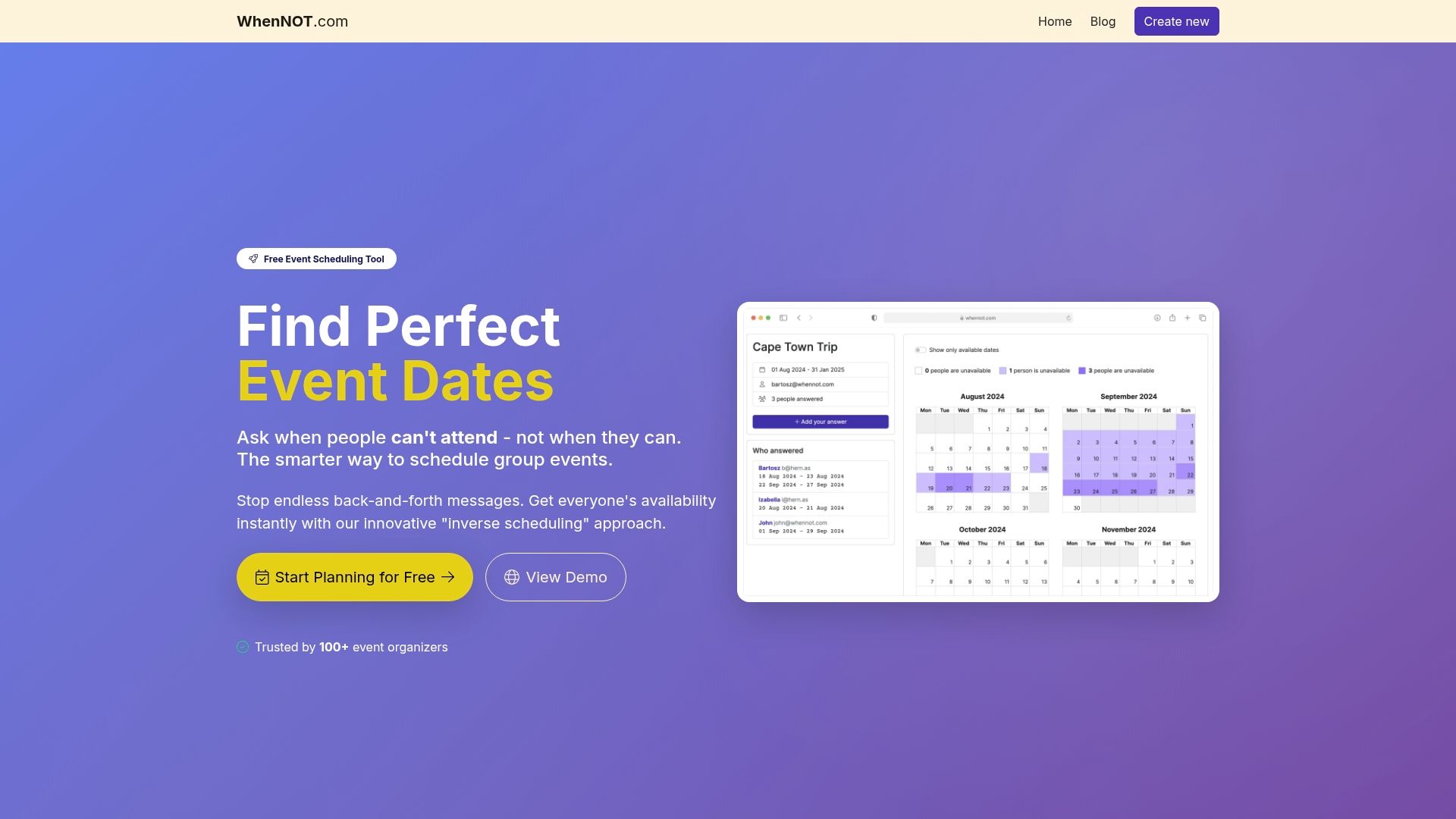Free scheduling tools are changing the way people plan meetings and group events. You might think these just help avoid double-bookings or clean up your calendar clutter. But the real surprise is in the numbers—organizations spend nearly 4.8 hours every week simply coordinating meetings. These tools are solving much bigger headaches than most people realize.
Table of Contents
- What Are Free Scheduling Tools And Their Purpose?
- Why Free Scheduling Tools Matter For Event Planning
- How Free Scheduling Tools Function And Connect Users
- Key Features To Look For In Scheduling Tools
Quick Summary
| Takeaway | Explanation |
|---|---|
| Free scheduling tools simplify coordination | They facilitate finding optimal meeting times, reducing email and message clutter. |
| No-cost features appeal to diverse users | Many platforms offer essential functionalities without subscription fees, making them accessible for everyone. |
| User-friendly interfaces enhance participation | Intuitive designs allow users with minimal tech skills to engage easily, encouraging broader collaboration. |
| Intelligent conflict detection streamlines planning | These tools automatically suggest alternatives when participants are unavailable, saving time and effort. |
| Cross-platform compatibility allows flexibility | Users can access scheduling tools across various devices, enhancing usability and convenience for all participants. |
What are Free Scheduling Tools and Their Purpose?
Free scheduling tools represent digital solutions designed to simplify the complex process of coordinating group events, meetings, and activities across multiple participants. These online platforms provide a centralized mechanism for managing time availability, reducing communication barriers, and streamlining planning efforts.
Understanding the Core Functionality
At their fundamental level, free scheduling tools function as collaborative platforms that help groups find mutually convenient times without extensive back-and-forth communication. They eliminate traditional challenges like email chains, text message confusion, and manual calendar comparison. Research from Gartner indicates that organizations spend approximately 4.8 hours per week coordinating meetings, making these tools critically important for efficiency.
The primary purposes of free scheduling tools include:
- Simplifying group coordination across different time zones
- Reducing communication overhead
- Providing transparent availability tracking
- Enabling quick decision making for event planning
Key Benefits for Different User Groups
Free scheduling tools serve diverse user segments with unique needs. For business professionals, these tools transform meeting coordination by allowing participants to share availability seamlessly. Academic groups can synchronize study sessions or project meetings across complex schedules. Social event planners can quickly determine optimal times for gatherings without endless messaging.

Key differentiators of modern free scheduling tools include:
- No Cost: Most platforms offer basic features without financial commitment
- User Friendly Interfaces: Intuitive design requiring minimal technical expertise
- Cross Platform Compatibility: Functioning across various devices and operating systems
By providing a standardized approach to time management, free scheduling tools have become essential digital utilities for collaborative planning. They represent more than mere convenience—they are productivity enablers that transform how groups coordinate and communicate in an increasingly complex, time-sensitive world.
To help readers understand the specific advantages of free scheduling tools for various types of users, the following table summarizes key benefits by user group.
| User Group | Key Benefits |
|---|---|
| Business Professionals | Streamlined meeting coordination, seamless availability sharing |
| Academic Groups | Easily schedule study sessions and project meetings |
| Social Event Planners | Quickly determine optimal times for gatherings |
| All Users | Reduced communication overhead, transparent availability tracking |
Why Free Scheduling Tools Matter for Event Planning
Event planning involves intricate coordination among multiple participants, each with unique schedules and constraints. Free scheduling tools have emerged as critical solutions that transform the traditionally complex process of organizing gatherings, meetings, and group activities.
Addressing Scheduling Complexity
Coordinating events requires navigating multiple availability windows, personal commitments, and logistical challenges. Research from Eventbrite reveals that event organizers spend an average of 30% of their planning time managing participant schedules. Free scheduling tools dramatically reduce this administrative burden by providing intelligent platforms that streamline communication and decision making.
Specific scheduling challenges these tools effectively resolve include:
- Eliminating endless email and message threads
- Preventing scheduling conflicts
- Providing real time availability tracking
- Supporting large group coordination
Time and Resource Optimization
Beyond mere convenience, free scheduling tools represent significant productivity investments. They convert manual coordination efforts into automated, efficient processes. Business teams, academic groups, and social event planners can redirect time previously spent on scheduling towards more meaningful activities.
Key advantages of these tools in event planning encompass:
- Instant Availability Comparison: Quickly identify optimal meeting times
- Reduced Communication Overhead: Minimize back-and-forth interactions
- Comprehensive Schedule Management: Track participant availability across different platforms
By offering intuitive, accessible solutions, free scheduling tools democratize event planning.
 They empower individuals and groups to coordinate complex gatherings with unprecedented ease, transforming how we approach collective time management in an increasingly interconnected world.
They empower individuals and groups to coordinate complex gatherings with unprecedented ease, transforming how we approach collective time management in an increasingly interconnected world.
How Free Scheduling Tools Function and Connect Users
Free scheduling tools leverage advanced digital technologies to simplify complex group coordination processes. These platforms create virtual spaces where multiple participants can seamlessly share and compare availability without traditional communication barriers.
Technological Foundation of Scheduling Platforms
Research from MIT Technology Review demonstrates that modern scheduling tools integrate sophisticated algorithms that analyze individual time preferences and constraints. These systems utilize cloud-based technologies to enable real time synchronization across different devices and geographic locations.
Key technological components include:
- Intelligent calendar integration
- Automated conflict detection mechanisms
- Cross platform compatibility
- Secure data transmission protocols
User Connection and Interaction Mechanisms
Scheduling tools typically operate through intuitive invitation and response frameworks. Event organizers generate unique links that participants can access without requiring extensive registration processes. This approach reduces friction and encourages wider participation across diverse user groups.
Primary connection strategies involve:
- Minimal Authentication: Allowing quick access without complex sign up processes
- Flexible Participation: Supporting various input methods
- Real Time Updates: Providing instant visibility into group availability
By transforming complex scheduling challenges into streamlined digital experiences, these tools create collaborative environments that transcend traditional communication limitations. They represent more than technological solutions—they are bridges connecting people through intelligent, user centric design.
Key Features to Look for in Scheduling Tools
Choosing the right scheduling tool requires understanding the critical features that transform a basic platform into a powerful coordination solution. Not all scheduling tools are created equal, and discerning users must evaluate multiple aspects to ensure effective group planning.
Essential Functional Capabilities
Research from Gartner highlights that successful scheduling platforms must provide robust functionality beyond simple calendar sharing. The most effective tools offer comprehensive features that address complex coordination challenges across different user scenarios.
Critical functional requirements include:
- Seamless calendar synchronization
- Multi platform accessibility
- Intuitive user interface
- Advanced privacy control mechanisms
Advanced Usability and Integration Considerations
Beyond basic functionality, top tier scheduling tools differentiate themselves through sophisticated integration capabilities and user experience design. The goal is creating platforms that minimize friction and maximize collaborative efficiency.
Key advanced features to consider:
- Intelligent Conflict Resolution: Automatically detecting and suggesting alternative time slots
- Cross Platform Compatibility: Supporting multiple devices and operating systems
- Privacy Protected Sharing: Enabling granular control over personal availability information
The most effective scheduling tools transcend mere technical utility. They become strategic communication platforms that simplify complex group coordination while maintaining user privacy and maintaining intuitive interaction models. Selecting the right tool means finding a balance between comprehensive features and user friendly design.
The following table organizes the critical features and advanced capabilities to look for when choosing a free scheduling tool, helping readers evaluate platforms more easily.
| Feature | Description |
|---|---|
| Calendar Synchronization | Integrates and updates with existing electronic calendars |
| Multi-Platform Accessibility | Usable across different devices and operating systems |
| User-Friendly Interface | Simple, intuitive design for all skill levels |
| Privacy Controls | Offers granular settings to protect participant availability information |
| Conflict Detection | Identifies scheduling clashes and suggests alternative times |
| Real-Time Updates | Reflects availability changes instantly for all participants |
Make Group Event Planning Effortless with WhenNOT
Struggling to coordinate everyone’s busy schedules for your group event? As highlighted in this article, free scheduling tools exist to eliminate frustrating email chains and endless calendar comparisons. Yet traditional solutions still ask for everyone's availability, adding to the complexity, especially if you're planning a multi-day event or need flexible dates. What if you could instantly visualize when people are not busy and save even more time?

Discover WhenNOT, the online scheduling tool designed for true simplicity. Instead of gathering when people can meet, WhenNOT focuses on when participants are unavailable, making it incredibly easy to find the best date with just a few clicks. There are no signups, everyone’s privacy is protected, and you can see group conflicts at a glance. Organize hassle-free meetings, family gatherings, or corporate events today. Visit WhenNOT’s homepage and create your first event now to experience efficient group planning yourself.
Frequently Asked Questions
What are free scheduling tools?
Free scheduling tools are digital platforms designed to streamline the process of coordinating group events, meetings, and activities by allowing participants to share and compare their availability effortlessly.
How do free scheduling tools help in event planning?
These tools address scheduling complexities by minimizing email and message exchanges, preventing conflicts, and providing real-time availability tracking, thus optimizing the event planning process.
What key features should I look for in a scheduling tool?
Essential features include seamless calendar synchronization, multi-platform accessibility, an intuitive user interface, and privacy control mechanisms for protecting personal availability information.
Can I use free scheduling tools on different devices?
Yes, most free scheduling tools are designed to function across various devices and operating systems, ensuring that users can access and manage their schedules from anywhere.
